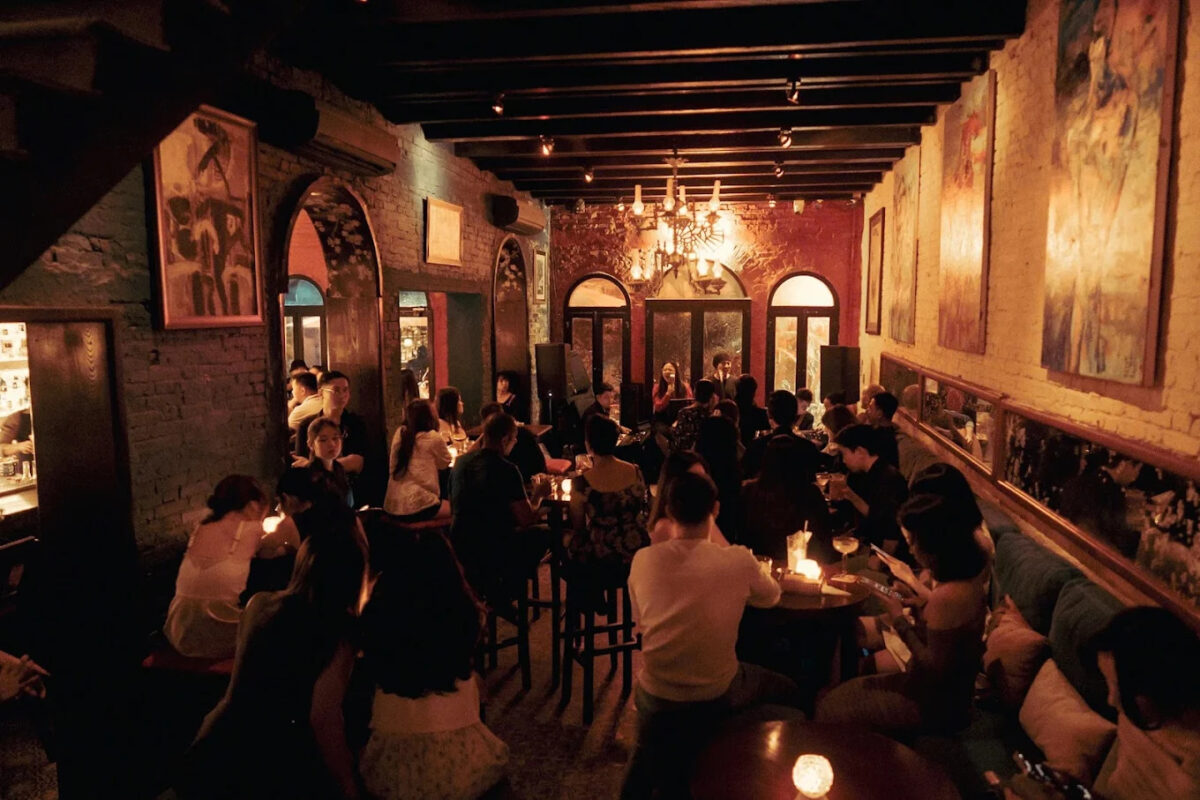Some places make you pause the moment you arrive. Cao Dai Temple in Tay Ninh is one of them.
While many temples start to feel the same, this one quietly stands apart. Behind its pastel walls and dragon pillars lives a belief system born in southern Vietnam. It blends East and West, tradition and vision, in a way that feels both surprising and deeply local.
If you’re looking beyond the usual photo stops and want to feel what this place really means, you’re already on the right path.
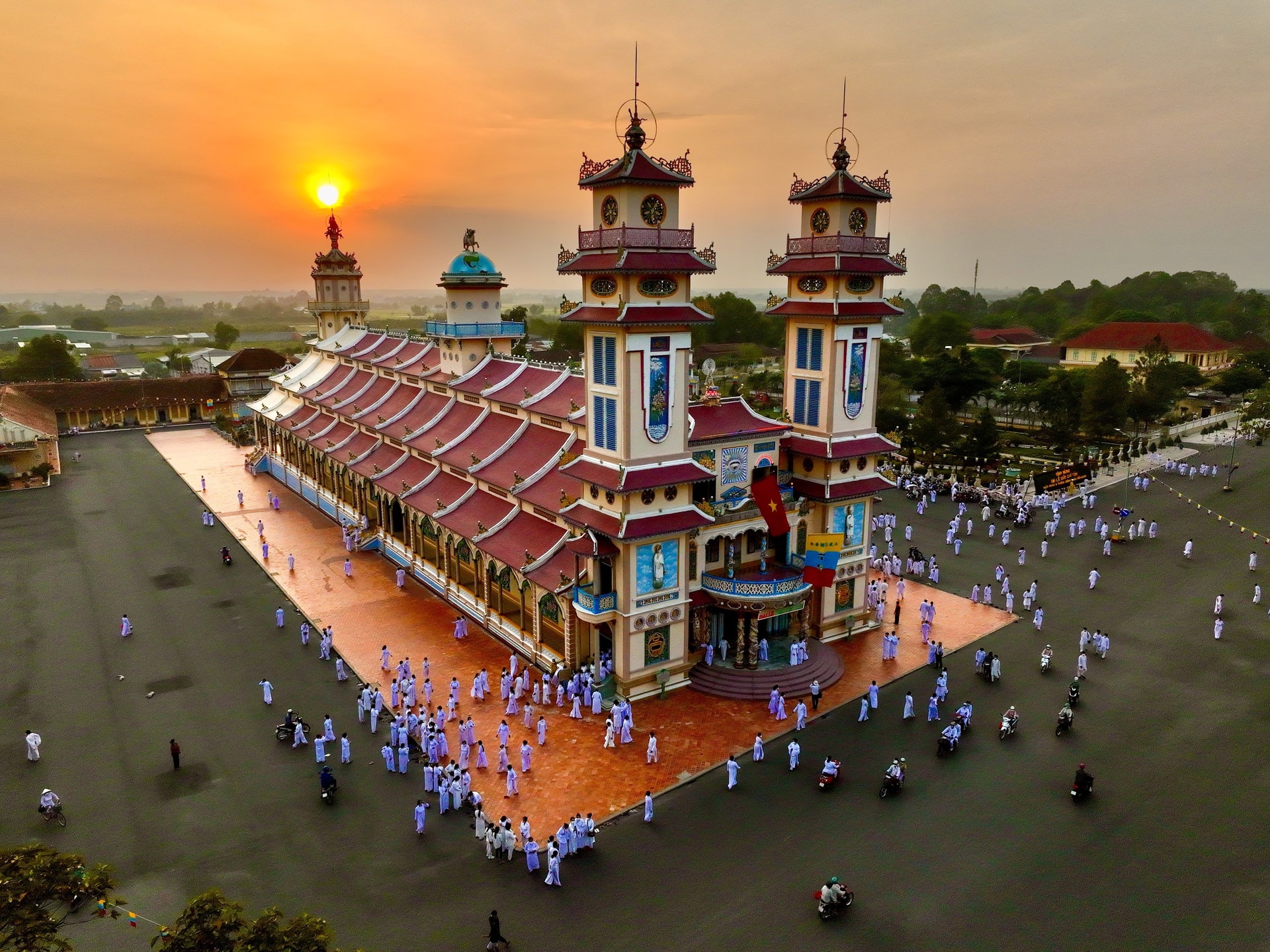
Discover Cao Dai Temple in Tay Ninh: A spiritual treasure worth slowing down for
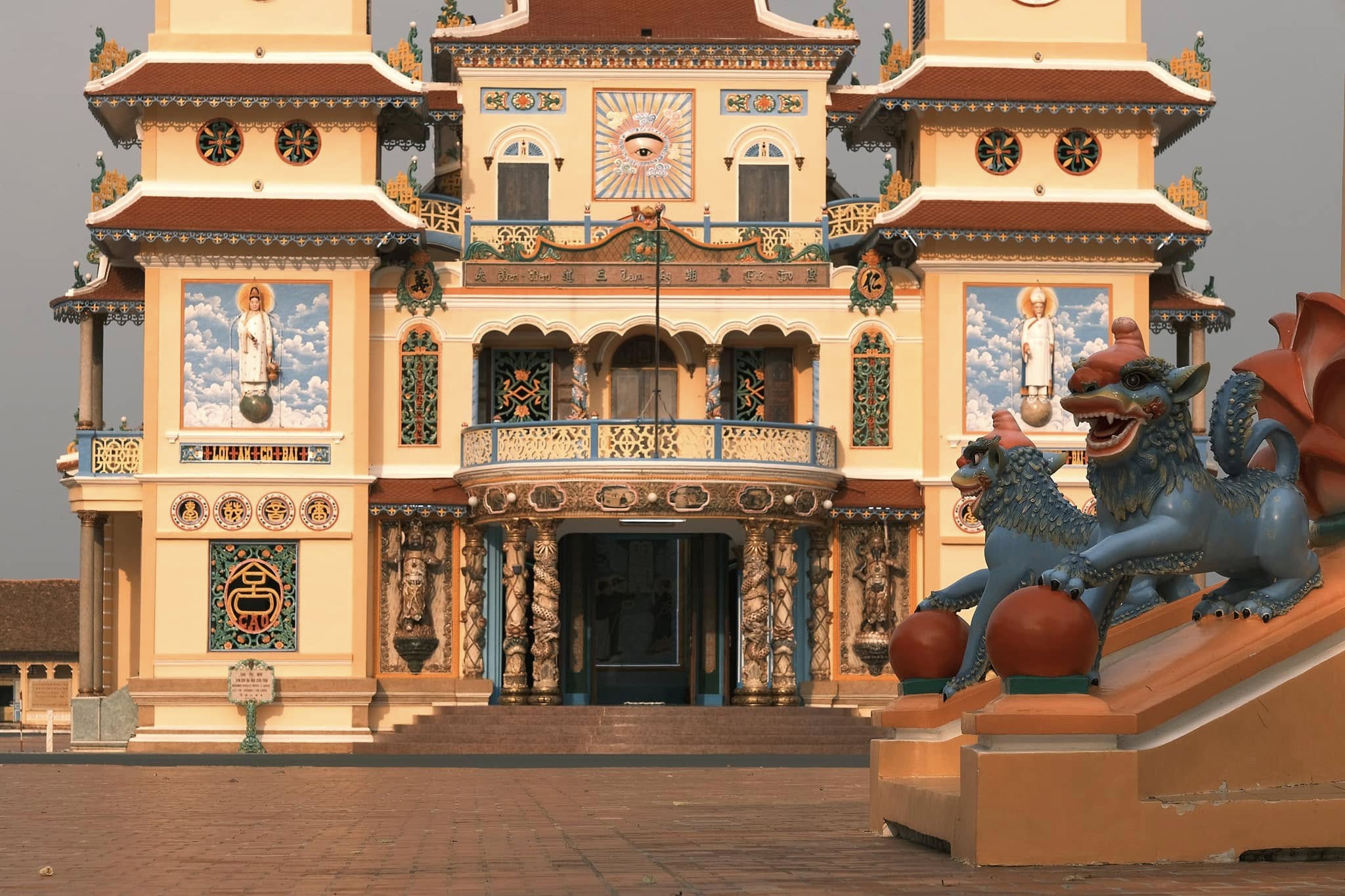
From a distance, the Cao Dai Holy See looks like something from a watercolor painting. Soft pink towers rise into the sky. Dragon-wrapped columns guard the entrance. Every corner is filled with symbols waiting to be noticed.
But this temple isn’t just beautiful. It carries a quiet spirit that stays with you.
Built between 1933 and 1955, Cao Dai Temple is the heart of Caodaism, a Vietnamese religion that began here in Vietnam during a time of change. Through political shifts and decades of history, this sacred space has remained steady, offering peace to believers and wanderers alike.
Whether you’re visiting alone or with a group, you’ll find that the temple gently invites you to pause. To look longer. To listen more closely. The deeper you slow down, the more the place begins to speak.
Want to understand the full story?
Watch this short documentary on the rise of Caodaism and the role of Tay Ninh’s temple:
What is Caodaism?
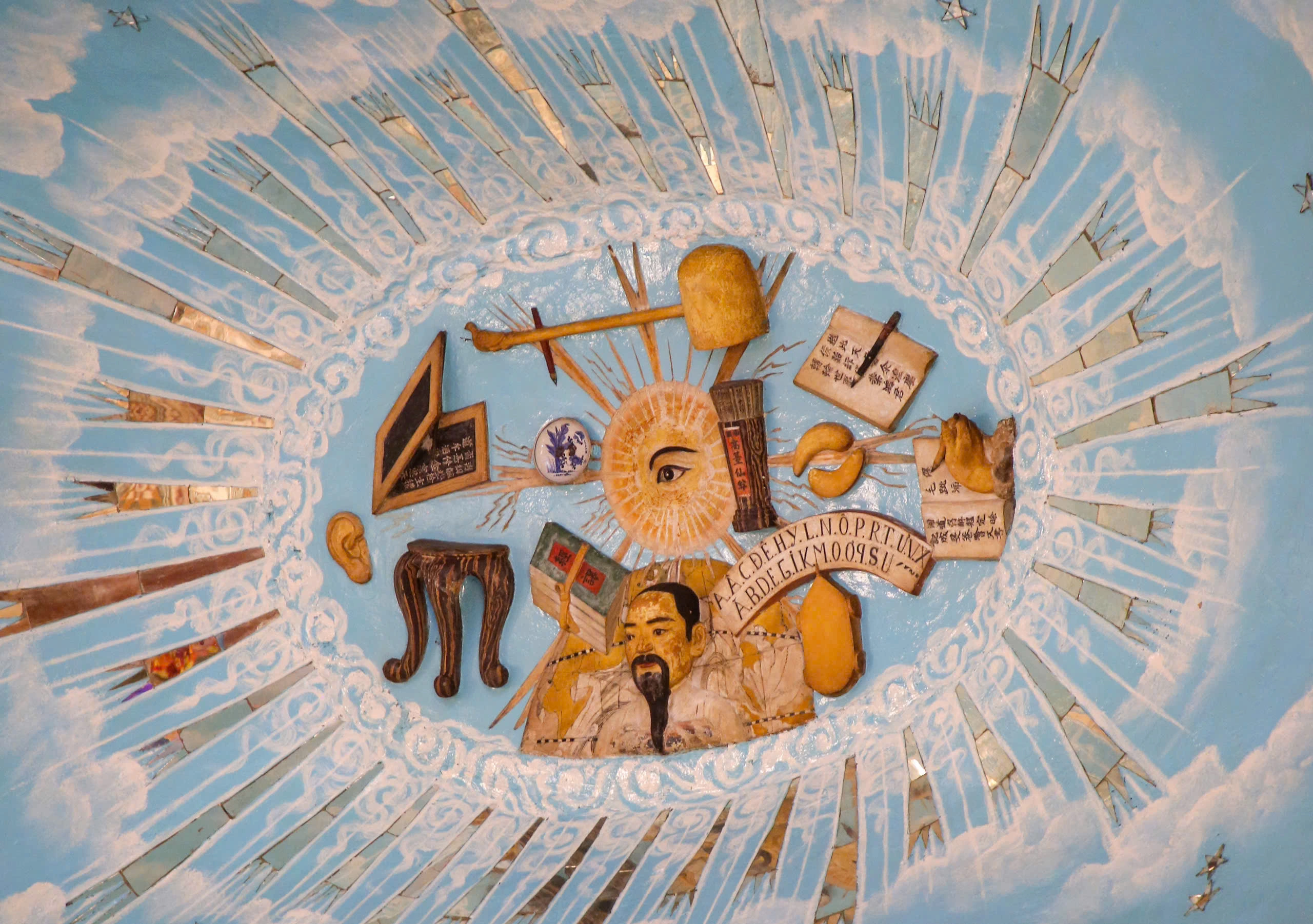
Caodaism, or Đạo Cao Đài, is a homegrown Vietnamese religion founded in 1926, but its spirit is global. It combines the teachings of Buddhism, Taoism, Confucianism, Christianity, Islam, and even spiritualism. The goal is to unite beliefs and guide people to live peacefully, morally, and with compassion.
The heart of Caodaism lies in its message: all religions share the same roots, and we are all guided by the same light. This belief is reflected in everything from the Divine Eye symbol you’ll see above the altar to the way followers dress in pure white, showing unity and equality.
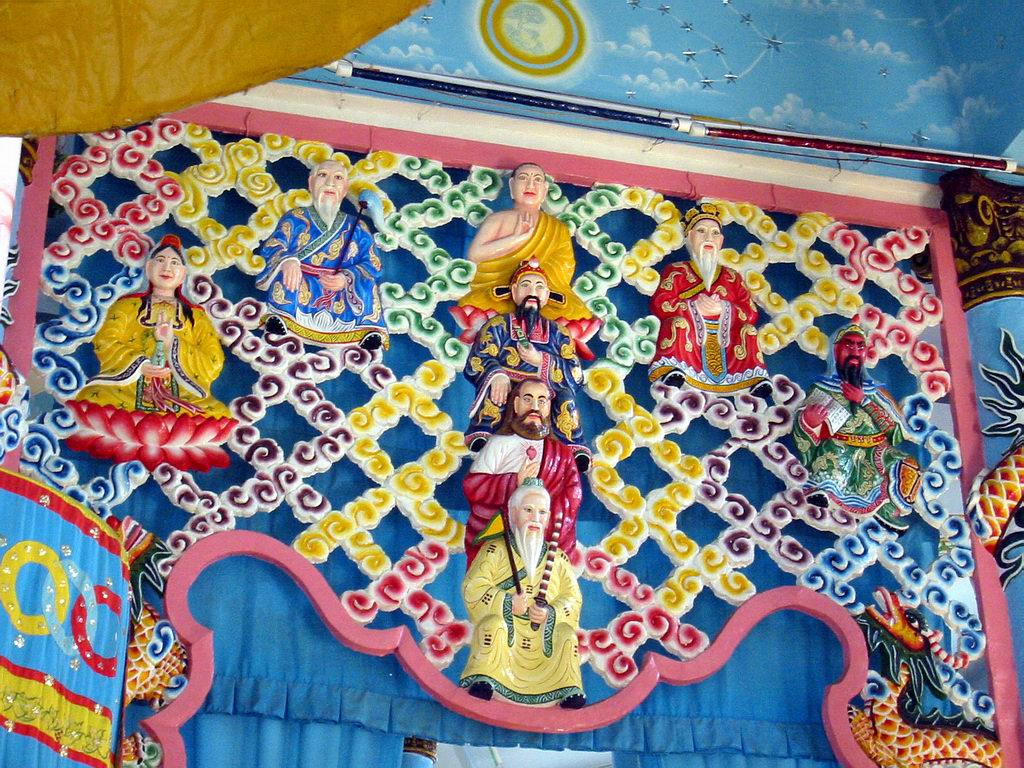
What makes it even more fascinating is that its saints include not only religious figures but also cultural icons like Victor Hugo and Sun Yat-sen. It’s a faith that crosses borders, honors both East and West, and welcomes anyone searching for meaning.
A closer look at Cao Dai Temple’s symbolic design
A dreamlike temple built with purpose
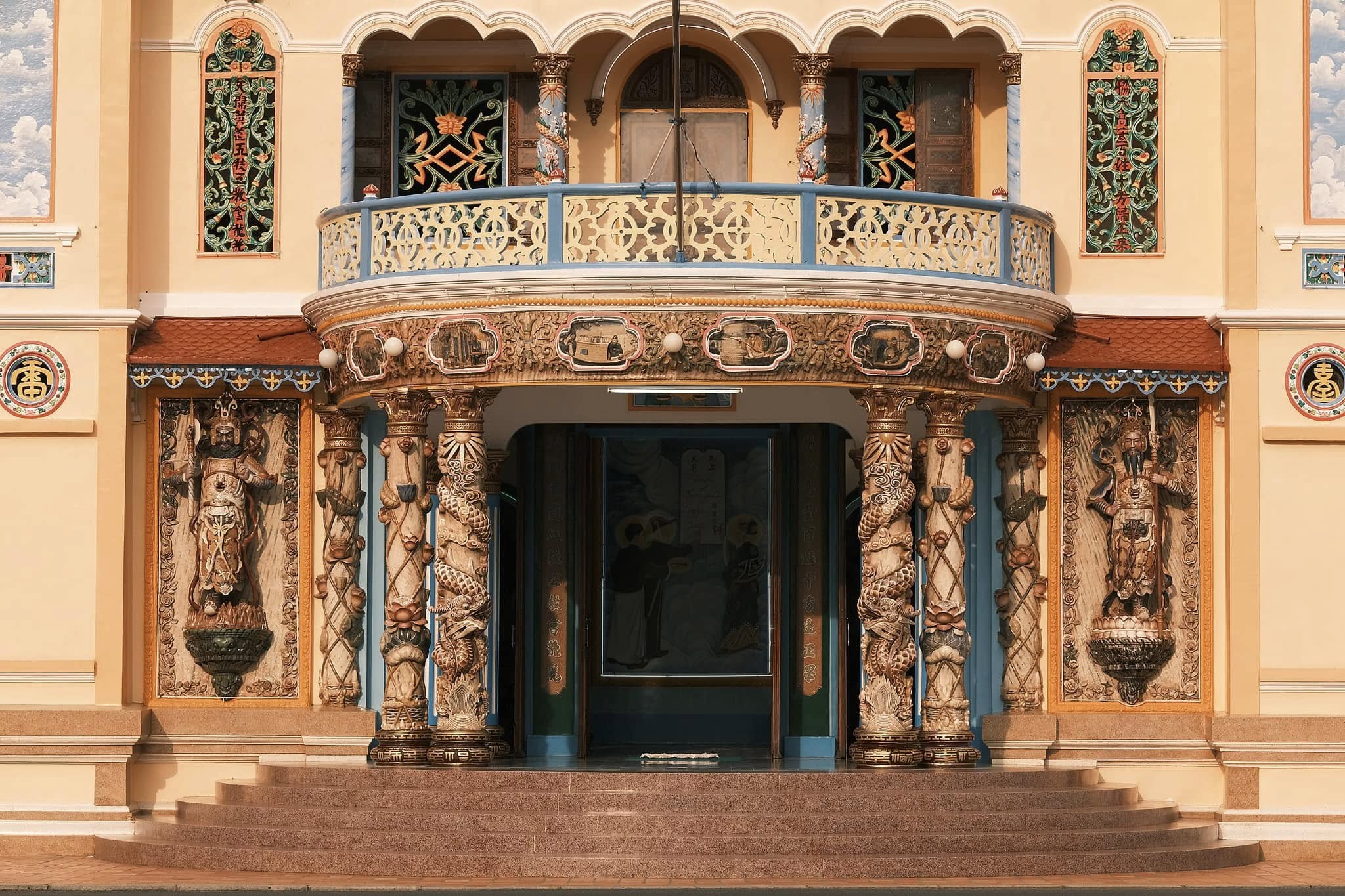
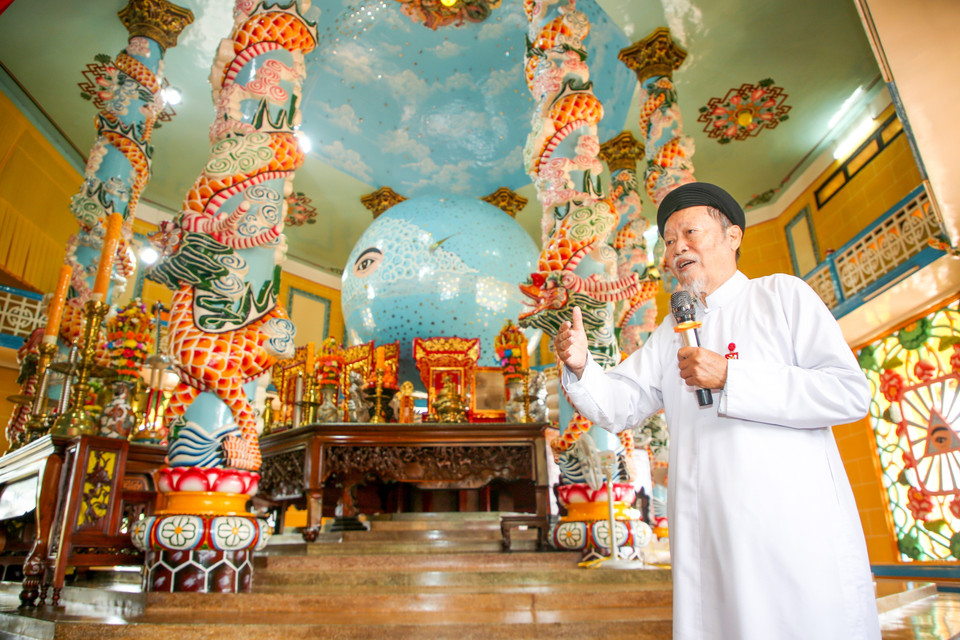
From the moment you arrive, Cao Dai Temple feels like it belongs in a dream. Pastel towers, curled dragon columns, and a sky-blue ceiling painted with soft clouds create a scene that feels both peaceful and surreal. But behind the beauty is a deep meaning shaped by faith.
The architecture brings together influences from different cultures. You might spot the arches of a European church, the curves of a Chinese pagoda, and the layout of a traditional Vietnamese temple. This mix reflects the heart of Caodaism, where all spiritual paths are seen as one.
Everything in the temple was designed with intention. Built with bamboo-reinforced cement, the structure shows local resourcefulness. From the placement of the Divine Eye to the path of the central aisle, each part quietly guides visitors toward reflection and harmony.
Exploring the meaning behind its symbols
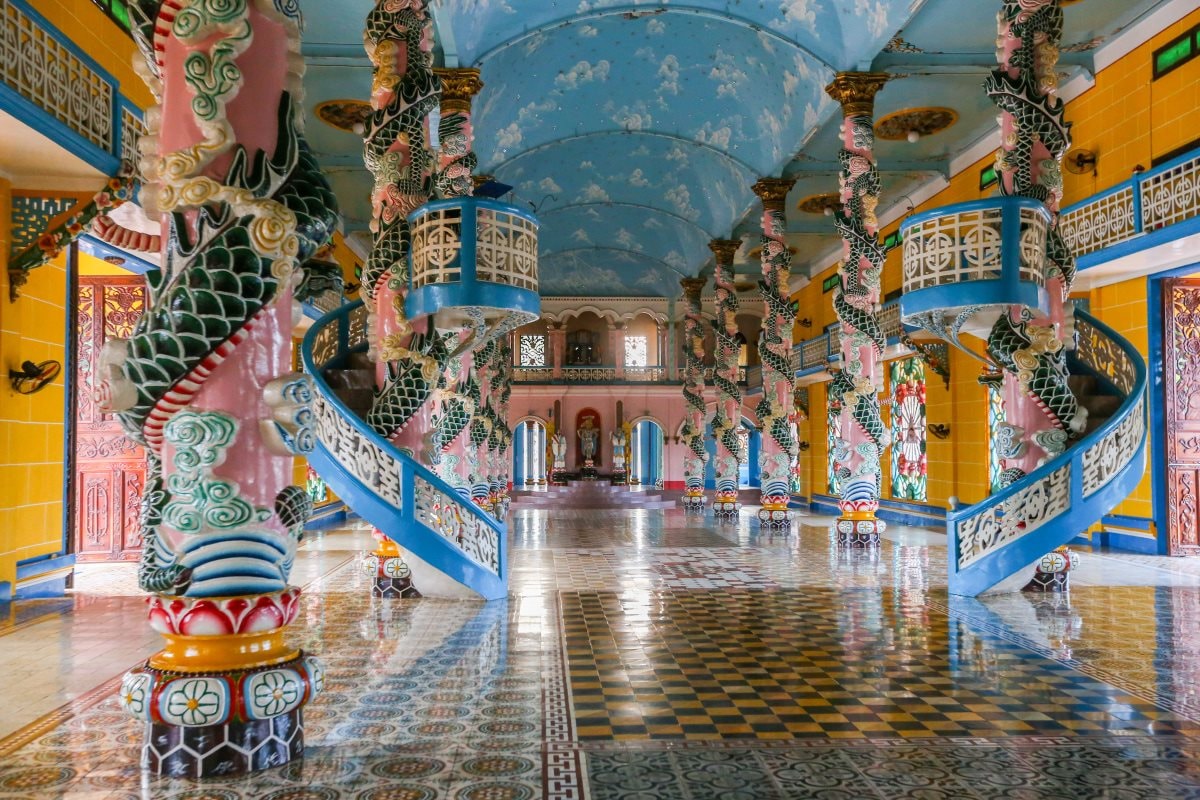
As you step into the main hall of Cao Dai Temple, you’re stepping into a space where every detail speaks. The colors, the shapes, and the symbols are not just decorations. They are part of a story that helps connect people with the divine.

One of the first things you’ll notice is the Divine Eye. Sitting above the altar and watching over the hall, this symbol represents God’s wisdom and presence. You will also see it on the main gate, reminding visitors that this is a place of guidance and truth.
The colors used throughout the temple carry deep meaning. Yellow stands for Buddhism and compassion. Blue reflects Taoism and peace. Red represents Confucianism and morality. The white robes worn by followers speak of purity and equality. Everything has been chosen with care, not just for beauty but for purpose.
Look down, and you’ll see nine steps leading toward the altar. These steps represent the spiritual journey to enlightenment. Visitors are invited to walk along the side aisles while the center path remains for the clergy. It’s a simple but respectful way to honor the sacred.
You may also notice the 28 dragon-wrapped columns that line the hall. These represent spiritual protection and strength. Near the altar, the seven-headed cobras stand quietly, symbolizing the seven human emotions and the importance of inner balance.
Spending a few moments to observe these details can turn your visit into something more meaningful. It’s not just what you see, but what you begin to feel.
Want to explore deeper?
Watch this short video to discover how each part of the temple reflects Caodaism’s teachings:
What to know before visiting Cao Dai Temple in Tay Ninh
A peaceful ceremony open to all
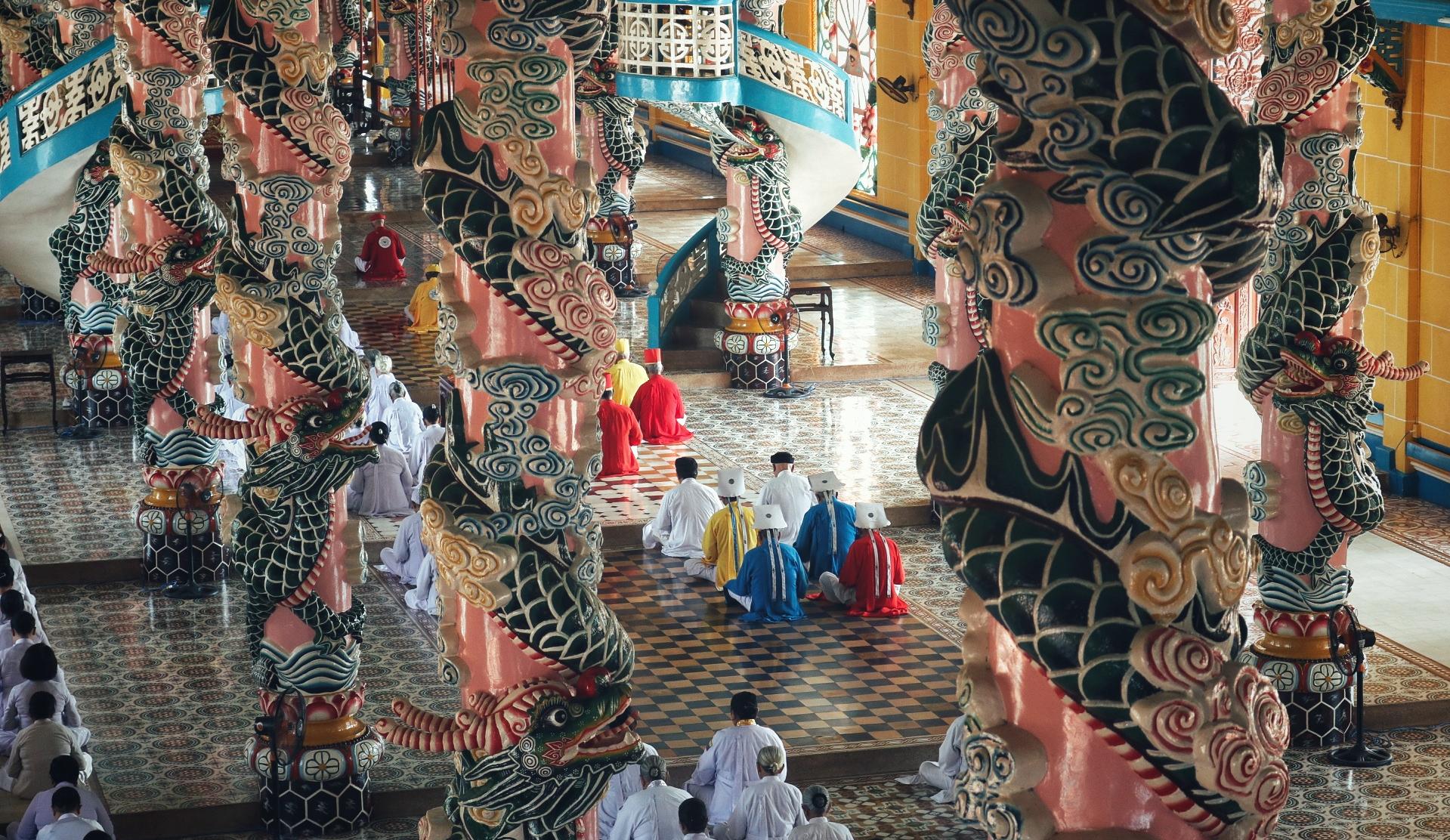
Every day, Cao Dai Temple holds four prayer ceremonies at 6 AM, 12 PM, 6 PM, and midnight. The noon ceremony is the most popular, especially for visitors coming from Ho Chi Minh City. As you enter, you’ll see rows of worshippers in white robes, sitting in stillness while priests in vibrant colors lead the prayer.

The music is soft and spiritual, played live by an orchestra blending Vietnamese and Western instruments. Visitors are welcome to quietly watch from the upper balcony, where you can see the entire main hall without interrupting the ritual.
Even if it’s your first time, the calm atmosphere makes it easy to follow along. The focus is not just on observation but on feeling the stillness, harmony, and respect that fill the space.
Respectful tips for first-time visitors
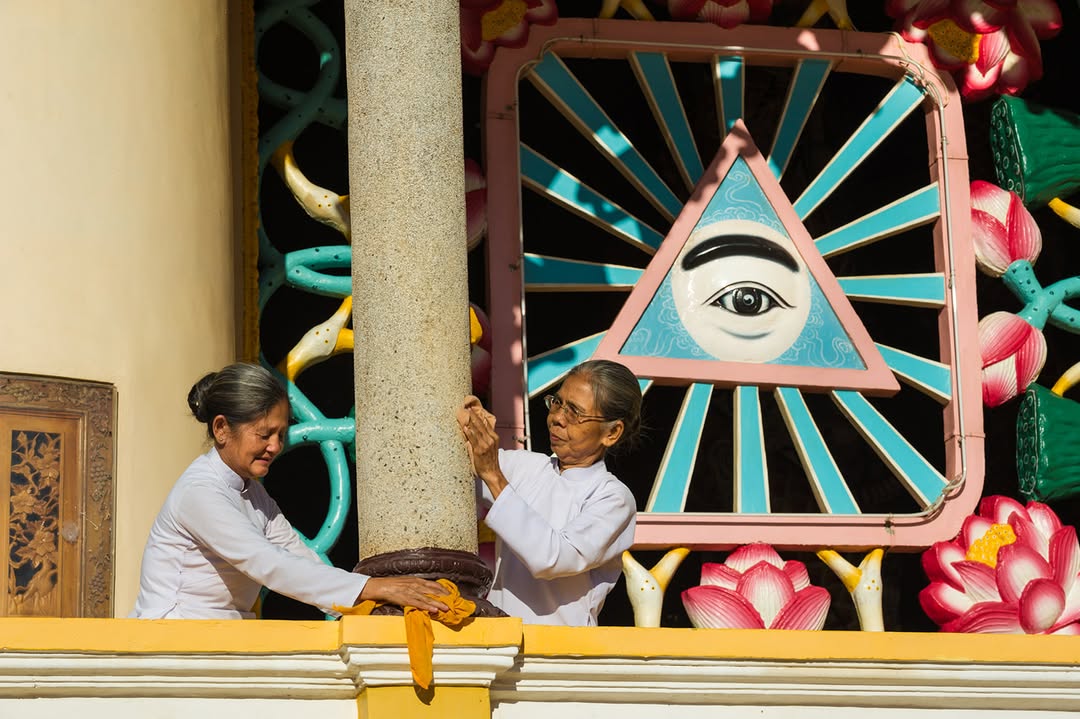
Cao Dai Temple is an active place of worship, so a little mindfulness goes a long way. Dress modestly, covering your shoulders and knees, and remember to remove your shoes before entering. Flash photography and loud conversations are best avoided to keep the space calm for everyone.
Men and women use different entrances: men enter on the right, women on the left. Walk along the side aisles or view the ceremony from the upper balcony. These quiet gestures of respect help preserve the temple’s peaceful atmosphere.
If you’re ever unsure, just follow the locals. Their quiet presence and gentle pace will guide you. Visitors often leave feeling not only welcomed, but also more grounded and connected.
Best time to visit Cao Dai Temple
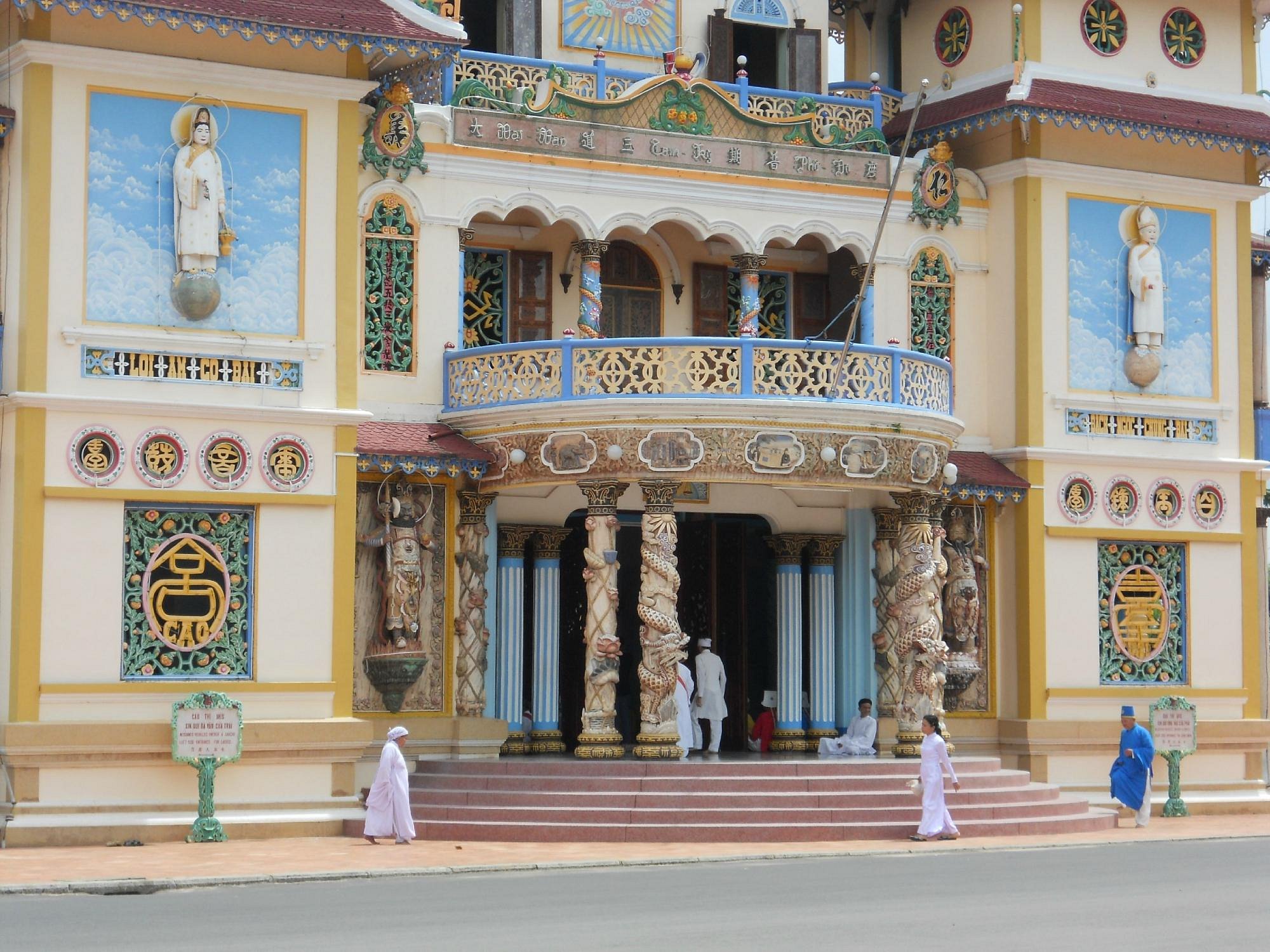
If you’re planning a visit, timing can make all the difference. The noon ceremony is the most popular and easiest to catch on a day trip from Ho Chi Minh City. It’s when the temple is most vibrant, filled with white-robed worshippers and gentle music flowing through the hall.
For a quieter moment, consider arriving early for the 6 AM ceremony. The temple feels fresh and calm in the morning light, and the soft glow on the pastel towers makes it perfect for photography too.
Try to arrive at least 15 to 20 minutes before the ceremony begins. It gives you time to find a good spot on the balcony, settle in, and truly take in the space before the prayers begin.
How to get to Cao Dai Temple from Ho Chi Minh City

Getting to Cao Dai Temple from Ho Chi Minh City is easier than it sounds. The most convenient option is taking a limousine bus. These small, comfortable vans have wide seats, air conditioning, and often Wi-Fi. They’ll take you straight to Tay Ninh City in about 2.5 to 3 hours.
Once you arrive, it’s a short 10 to 15-minute taxi ride to the temple gates. Trusted providers include:
- Saco Travel – well-known, around 6 to 9.50 USD | 1900 6027
- Thảo Kim Ngân – budget-friendly, around 2.50 USD | 1900 8153
- Kim Ngân Limousine – frequent trips, around 4.50 USD | 0911 377 799
If you want more than just transportation, consider joining a guided tour that includes both Cao Dai Temple and the Cu Chi Tunnels. With a local guide, the journey becomes more than just a checklist. You’ll hear real stories, understand the history, and notice details that bring everything closer.
At Jackfruit Adventure, we believe it’s those local voices that turn a place into a memory. On our cycling tours in Saigon, we ride alongside you through small alleyways, hidden temples, and vibrant communities. Each stop becomes a chance to listen, learn, and feel something real.
Whether you’re heading to Tay Ninh or exploring Saigon’s backstreets, sometimes all it takes is someone local to help you see the spirit behind the walls.
Other Cao Dai temples you can visit across Vietnam
Tay Ninh is the heart of Caodaism, but its spirit lives across the country. If you cannot make the trip to the Holy See, there are still other ways to experience the faith.
Here are other places where you can visit Cao Dai temples:
Cao Dai Temple in Da Nang
In central Vietnam, the Cao Dai temple in Da Nang is located close to the Han River. Its colorful design and peaceful space offer a moment of reflection for travelers exploring this vibrant city. It is easy to reach from the city center and often less crowded.
Cao Dai Temple in Phu Quoc Island
On this quiet island, Phu Quoc Cao Dai temple stands near Duong Dong Town. It is small but active, often visited by locals. After visiting the temple, you can continue your day relaxing at nearby beaches or enjoying fresh seafood.
Cao Dai Temple in Ho Chi Minh City
Right in the middle of Saigon’s vibrant life, you’ll find Cao Dai temples tucked inside alleyways and old neighborhoods. To experience them through a local lens, take a Trails of Quach Dam: Chinatown Discovery tour with Jackfruit Adventure. This cycling journey takes you beyond the surface of District 5, into the living heritage of temples, markets, and quiet corners where stories are still shared every day.
For a broader route, the Saigon Off-the-Beaten-Path tour weaves through lesser-known districts, where everyday life unfolds gently. Along the way, you might visit a local temple, meet a street vendor, or simply hear the city in a different way.
Each stop is a reminder that Saigon holds more than its skyline.
Sometimes, meaning is waiting in the quietest places.
Explore more than Cao Dai Temple with Jackfruit Adventure
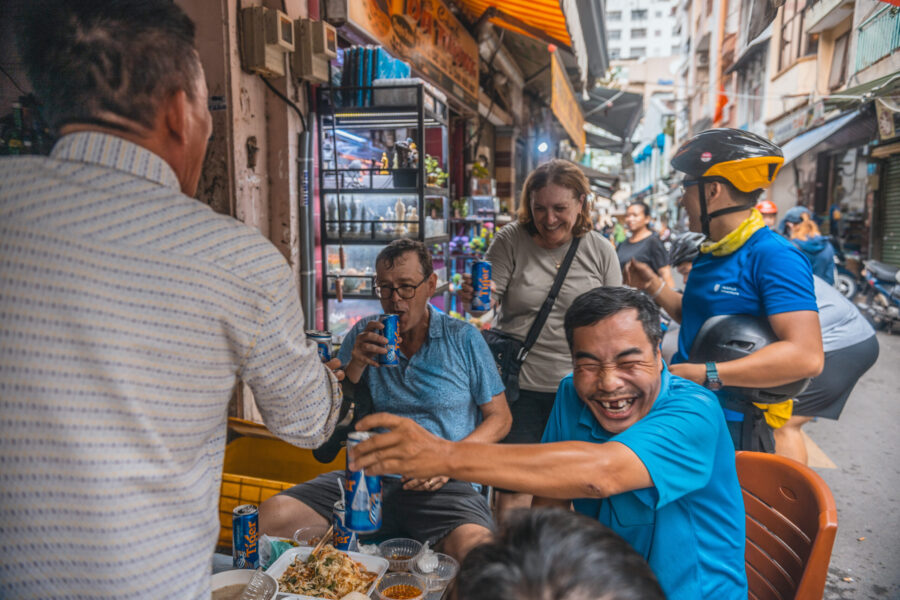
If your visit to Cao Dai Temple gave you a moment to pause and connect, there’s even more waiting for you back in Saigon. Beyond the traffic and landmarks, the city holds quiet temples, vibrant communities, and hidden alleyways where everyday life tells a deeper story.
At Jackfruit Adventure, our cycling tours are designed to show you the unusual things to do in Ho Chi Minh City. You might stop by an old Cao Dai temple in Chinatown, chat with locals at a hidden street food corner, or visit spiritual spots like Phu Chau Floating Temple.
No crowds. No rush. Just you, your bike, and stories told by people who call this city home.
Join a Jackfruit cycling tour and let the city unfold at your pace.
Every pedal brings you closer to Saigon’s quiet magic.




